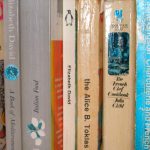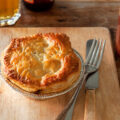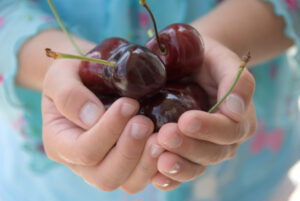Virgil Evetts
How many times have you heard it? Usually from the young and fervent, or the bored and vapid: ‘this book changed my life!’ I tend to stop listening at about that point, because what follows is usually a florid description of the latest self-help tome from the Oprah list. You know the sort of thing- three hundred pages of that very American brand of uber-politeness all to state the bleeding obvious: stop whining and pull yourself together. Not a bad title for a book actually.
So I won’t be offended if you decide to quietly back out of the room when I tell you that these books – the ones described below – really have changed my life. This is Foodlovers, so, yes, they’re all food books, and it might sound shallow and trivial when I say these titles have not just informed how I cook, but how I think about food, life and the world in general.
I don’t expect you to agree – nor do I claim that this is any kind of essential reading list. These are just the books that helped shape me into the sad little food-o-phile I am today. These books make me happy, hopeful and hungry.
The Edmonds Cook Book -1970s editions
I was a weird kid by kiwi standards. I didn’t like sports, my wardrobe was heavily influenced by my mother’s hippie-dippy sensibilities (I thought nothing of going to school in cow-skin moccasins, gold silk jeans and a red velveteen sweater), I was forever chasing butterflies – literally – and my idea of recreational bliss was an afternoon spent baking.
The first book that really opened my eyes to flour, butter and a nice hot oven, the one that taught me that the kitchen wasn’t a scary place at all, was Edmonds. Every Friday after school (once Ollie Olsen had signed off) was baking time, and slowly but surely I worked my way through each and every recipe – several times. Of course, I still needed my mother’s hands-on instruction to learn what was involved in creaming butter, folding-in flour and bringing egg whites to stiff peaks (that was assumed knowledge in even the most basic cook books back then), but otherwise it was all straight forward and easy to follow stuff, even as a total kitchen virgin.
Another of my childhood abnormalities was a precocious fondness for flower gardening. Oh, how I longed to visit the Edmonds factory with its garish, twee plantings out-front, but my dreams were dashed, unrealised, when a developer knocked it down back in 1990.
I’m not mad on the updated, slightly la-de dah new version of Edmonds, which features all manner of supposedly modern recipes involving pesto, hummus and other things done better elsewhere. I think I’ll just stick with the copy I learned to bake from – complete with oil stains and a liberal dusting of flour – if you don’t mind.
Elizabeth David- Italian Food
My first copy of this, perhaps my favourite food book of all time, was a rather dog-eared 1960’s edition with charmingly kitsch cover art. I was in my late teens before I found it, long-forgotten at the back of a wardrobe, but was instantly hooked. It taught me that la cucina Italiana is a whole lot more than the ‘spaghetti and sauce’ idea I had in my head, and that glossy photos aren’t necessarily the measure of a good cook book. Save for a few line drawings, Italian Food is all text, cover to cover. Instead, the emphasis here is on the quality of the writing and the authenticity and reliability of the recipes. Although published in 1954, Italian Food is still, in my opinion, the greatest English-language book on the subject ever written – and I’ve read more than I care to recall. Unusually for the time, Elizabeth David writes with a deep respect for the Italian people and their cuisine: patronising pomposity was the usual tone in those days. Her work here is at times laugh-out-loud funny, but unerringly intelligent throughout. I remember being shocked to the very core of my know-it-all teenage being to find recipes for such modern and fashionable delights as pesto, saltimbocca and gelato, in a book that was nearly as old and moth-eaten as my parents.
Jane Grigson- Charcuterie and French Pork Cookery
There is natural progression from Elizabeth David to Jane Grigson. The two often referenced each other in their work, and both had a similarly authoritative, waspish tone and reverence for their subject matter. French Charcuterie and Pork Cookery was the book that first demystified the murky, frankly frightening world of charcuterie for me, and thereby triggered one of my most enduring food passions – home-cured meats.
Again, this book highlighted that all food fashions are really just revivals, featuring as it does recipes for Spanish style hams, pork rillettes, potently seasoned suacisson, and many other a la mode meaty pleasures. This book, more than any other, taught me to be brave in the kitchen, to take risks for good food – after all, the difference between a good ham and a bout of botulism is only a few grams of salt. I can think of no greater virtue for a food book.
Maggie Beer – Maggie’s Farm
This was the first book I found which successfully brought together my biggest extracurricular obsessions – growing good produce and cooking great food. Sure, there are plenty of other books for cooks who garden and gardeners who cook, but most seem to be either soulless affairs aimed at trainspotter types, or overly obsessed with pulses and respect for the Earth Mother. Maggie’s Farm is definitely a food book first and foremost, but it’s written with not just a cook’s love of good food, but a farmer’s love of the land. And although written from a decidedly Australian perspective, with a good measure of German-influenced Barossa cooking, I found a lot of familiarity here. The seasons were around the right way for one thing, so it didn’t make me feel excluded from the cool clique in the way northern hemisphere cook books sometimes do. And apart from just extolling the pleasures of cultivated food, Maggie’s Farm also delves into foraged food, another pet passion of mine. Using Maggie Beer’s instructions I even collected, purged and eventually poached a pot full of fat garden snails (which taught me I do not like poached snails). Forget A Year in Provence: this is the book to make you long for the lifestyle block idyll.
Australian Women’s Weekly Home Library: Chinese Cooking Class Cookbook
In the 1980s this series of books was everywhere. The glossy, magazine-style publication presents mouth-watering, accessible Chinese cooking in an idiot-proof format, and with competent but unintimidating photography. Admittedly many of the recipes are rather tame by today’s standards, but when I was growing up this book was like training wheels for Chinese cooking to me. Mum worked nights throughout my teens, so I had plenty of time to experiment with its many excellent, mostly Cantonese, dishes. While my friends and their families were presumably supping on stew and packet-mix macaroni-cheese, I was home alone, gorging myself on homemade crispy-skin chicken. Those were the days.
The Chicken with Lychee recipe from the Chinese Cooking Class Cookbook is still a much loved part of my family’s food repertoire, and the deep fried toffee apples… oh my God the deep fried toffee apples! This book looks a little sad and dated now, but I’m yet to find a more clearly laid-out beginners guide. Not only are the instructions simple and reliable (with step-by-step photographs), but the dishes taste great too.
Antonio Carluccio- The Carluccio Collection: Antipasti, Vegetables & Salads, Pasta, Mushrooms & Truffles, Fish and Shellfish, Meat, Poultry & Game, Desserts, Baking.
Although actually a serious of small books, I tend to think of these as one title, and it’s a shame they haven’t been released that way. I have a lot of time for Antonio Carluccio; he writes so lovingly of his native Italy, but with none of the patrician haughtiness of writers such as Lorenza de Medici. The phrase ‘salt of the earth’ comes to mind. This might just be the carefully crafted public persona of a shrewd businessman (which he surely is), but I’ll buy it.
Rather than just regurgitating clichés of Italian food, these books present reliable recipes for the sorts of dishes you might find in a small village trattoria, including tofeja del canavese (pork and beans), insalata di neonata (salad of baby anchovies), fichi al forno (baked figs) and many more.
Whereas Elizabeth David made me fall in love with Italian food, Antonio Carluccio, through these books, made me fall in love with the idea of Italy, and over successive visits and successive re-reads, in love with the land itself – maddening, breathtaking, filthy and gorgeous as it is.
And there you have it. My big 5.
And certainly, there are many other food books I have loved and learned from in various ways, but so far only this modest selection have actually changed my point of view. I hope this list will grow.
So have you too been moved by a cook book? Has Delia rocked your world or has Julia shown you the light?
Time to share…





Better late than never. Not only do I have the AWW Chinese cookbook but the Italian, Indian……… they were great as a starting place.
The New Zealand Radio and Television Cookbook is my favourite, edited by Alison Holst, a compilation of recipes sent in by everyday cooks- it represents our cooking history.
The Best of Anabelle Langbein is on the list
The Complete Asian Cookbook by Charmaine Solomon
The NZ Microwave Cookbook by Glenys Henry as a reference to adapt any recipe to the microwave- none of this washing pots for me!
The David Thompson ‘bible’ is indeed a great book- by my reckoning one of the best food books of the last couple of decades, but it is a little more exacting than even I have the patience for most of the time. Not that that’s a criticism- Thai food is very complex and this is a scholarly text /manual on the subject. I keep meaning to try his recipe for home made fish sauce. I have an earlier book of his which isn’t quite so fussy.
As much as her pouty flirtation on TV catches in my throat, Nigella is a very good writer. I can’t help but like her books- VASTLY superior to the great god Jamie Oliver.
The Constance Spry Cookery Book is another favourite. Very reliable and encyclopaedic in its breadth.
I rescued a boxed set of Elizabeth David’s from the post-house-move-throw-out my parents were having… sacrilege!
Your AWW Chinese book is what the AWW French cooking was to me at about the same age. I then moved on to “French regional cooking” by Anne Willan.
Love the David Thompson’s Thai one but like the previous poster, tend to take a few shortcuts from it.
Got several Delia Smith books, 2 Nigella Lawson’s which I dip into regularly.
Joy of cooking by Becker et al
My current fav is Ladies a plate :)
This was my collection in 2007 http://bp2.blogger.com/_7qsFJPvgdhI/Ry-xdJBJ-BI/AAAAAAAAAKU/qvcUORNGuqM/s1600-h/cookbooks.jpg now it is bigger *said in a tone of doom*
1. My first vote would be for Jane Grigson – I’d be tossing up between her Fruit Book and her Vegetable Book, but they are to me what Elizabeth David is to many other cooks of my generation – ie she made cookery from a wide range of culinary traditions accessible and ‘do-able’. Her books are both erudite and entertaining, and her recipes don’t date.
2. Secondly – Lois Daish, and particularly her Listener columns if that’s not cheating! She taught me about using local food in season, and her recipes aren’t pretentious – they are interesting and different and manageable in home kitchens.
3. Nikki and David Goldbeck’s The complete wholefood cuisine (pub in 1980s) is the best vegetarian recipe book I know – it uses a wide range of techniques and ingredients from many different culinary traditions, and is a never-ending source of inspiration when I want to broaden my vegetarian repertoire. It also explains some of the theory behind vegetarian cuisine – complementary vegetable proteins, etc.
1. The Edmond’s cookbook is a must. Where else do I find peanut brownies, afghans and ginger crunch all in one place.
2. Neil Perry – The Food I love. while it didn’t change my life it did change the way I cook meat.
3. Stephanie Alexander – Cooks Companion – it really is an essential.
4. thai food – David Thompson, the purists guide to Thai cooking and from which I adapt my own shortcuts.
5. The Essentials of Classic Italian Cooking – Marcella Hazan, we all need at least one good Italian book in our reportoire.
my favourite Go To book is the best of Annabel Langbein. I love it. I also have the cooks companion and i do like Nigella’s How to Eat and of course Domestic Goddess for baking.
My favourite, which you won’t have heard of, is The Solo Chef, by Val Clery – my Dad. He wrote a few cook books back in the 80s, but this is the one that drew me out of my ‘spag bog or cheese on toast’ student cuisine into the rhelm of experimentation. The recipes are simple and mainly aimed at producing great flavoured food when you get home from work, without slaving for hours. Instead of an index, it has a ‘food connector’, where you the three main ingredients are listed so you can picked a recipe based on what you happen to have already. Thanks Dad!
Nice topic, Virgil, but I haven’t as much time to respond as I would like. My first cooking book was a present from my mother when I left home. The Constance Spry Cookery Book. It is still one of the first sources I go to and my daughters each have a copy now and use it in the same way – a comprehensive ‘tome’ in the way that Stephanie Alexander’s Cooks Companion is now. I love that too and have given it as a present on 3 occasions.
The first book(s)I bought for myself is the boxed set of Elizabeth David which includes your much loved Italian Food (me too) although by the condition of the books the one I have used most is French Provincial Cooking – it is food stained and scribbled on by daughters who are in their forties now. The others are Summer Cooking, French Country Cooking and Mediterranean Food. All much loved and referred to as often now as they were forty years ago. She is both a writer’s cook and a cook’s writer. Inspirational.
Of my newer books the current ‘most dipped into’ would be Nigel Slater’s Real Food and Kitchen Diaries. Great food of the I’m not hungry but thank God I’m greedy variety. I have a few of Nigella’s but think I am over her. Perhaps influenced by recent cringe- making television.
I had a favourite AWW one too! The first Barbeque book had some lovely grub that became family favourites.
But best of all time? The Elizabeth David
Set. No contest.
I have a heavy tome, just under two kilos, that I deemed the only book worthy of dragging halfway around the world when I left England to come to Paradise. It is Good Housekeeping Look and Learn, actually four books in one:
First is Picture Recipes, covering every course from Hors d’Oeuvre to Sweets and including special chapters on curries, casserole making and Pastry and Cake Baking. The emphasis is on cookery as an art. It has such delights as Chilean Leche Nevada, simply beaten egg whites poached in milk and covered with custard made from the yolks; and Negre en Chemise, loosley translated as Black Nightdress, a simple chocolate dessert but Oh, so sexy-sounding………perfect for a ‘swinging sixites’ dinner party.
Family Favourites speakes for itself. Designed to help the housewife with everyday meals back in the days when everything was done ‘from scratch’. It teaches how to make things like raised, or hot water crust pastry, the sort used in pork pies, delicious eaten cold with that very tasty translucent jelly around the flavoursome meat. Or faggots, highly spiced meatballs made with the least desirable parts of the beast, the offal. Nothing is wasted, it’s all wrapped in a pig’s caul (afterbirth) to bake in the oven.
The Children’s Book is a step-by-step pictorial guide, starting with how to use a gas or electric oven, moving on to teaching basics such as ‘to cream’ and ‘to rub in’ and finishing with lots of simple recipes such as piped biscuits and scones.
Finally, Menus. My first Christmas without Mum was very ably assisted with this book. It covers Dinner parties, birthdays, etc. There are twenty four menus for each season of the year, a massive 96 menus so for every season and every occasion, we are spoilt for choice.
I still use this very dog-eared, stained and falling apart book. I treat it with the reverence it deserves and lovingly hold the pages together while browsing for that slightly ‘different’ dish, because as Virgil says, food doesn’t go out of fashion, it moves in circles and not very much is really new.